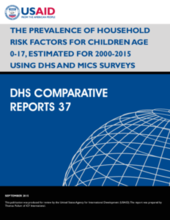Abstract
Children whose parents and households have certain characteristics are known to be more vulnerable to negative child outcomes. Four components of vulnerability have been identified by UNICEF: (1) the child has lost one or both parents; (2) the child is not living with either parent; (3) the child lives in a household in which no adult has any formal education; and (4) the child’s household is in the bottom two wealth quintiles. Children with the greatest vulnerability have components (1) and/or (2) and/or (3), and component (4). This report uses 80 surveys conducted by The Demographic and Health Surveys Program (DHS) and 55 Multiple Indicator Cluster Surveys (MICS), between 2000 and 2014 in 70 different countries, to estimate the prevalence of the components and combinations of vulnerability. These prevalences are combined with estimated numbers of children age 0-17, from the U.N. Population Division, to estimate the numbers of vulnerable children in the years of the surveys and in 2000, 2005, 2010, and 2015, except when those years are more than five years away from the survey dates. The countries with the highest combined prevalence are South Sudan, Burkina Faso, Niger, Mali, Guinea, Benin, Sierra Leone, Chad, Afghanistan, and Senegal. In these countries, 27% to 36% of children age 0-17 are in the combination of greatest vulnerability. Afghanistan has the highest combined prevalence outside of sub-Saharan Africa. These prevalences and population estimates may be used to assess the need for assistance and the coverage of programs.

